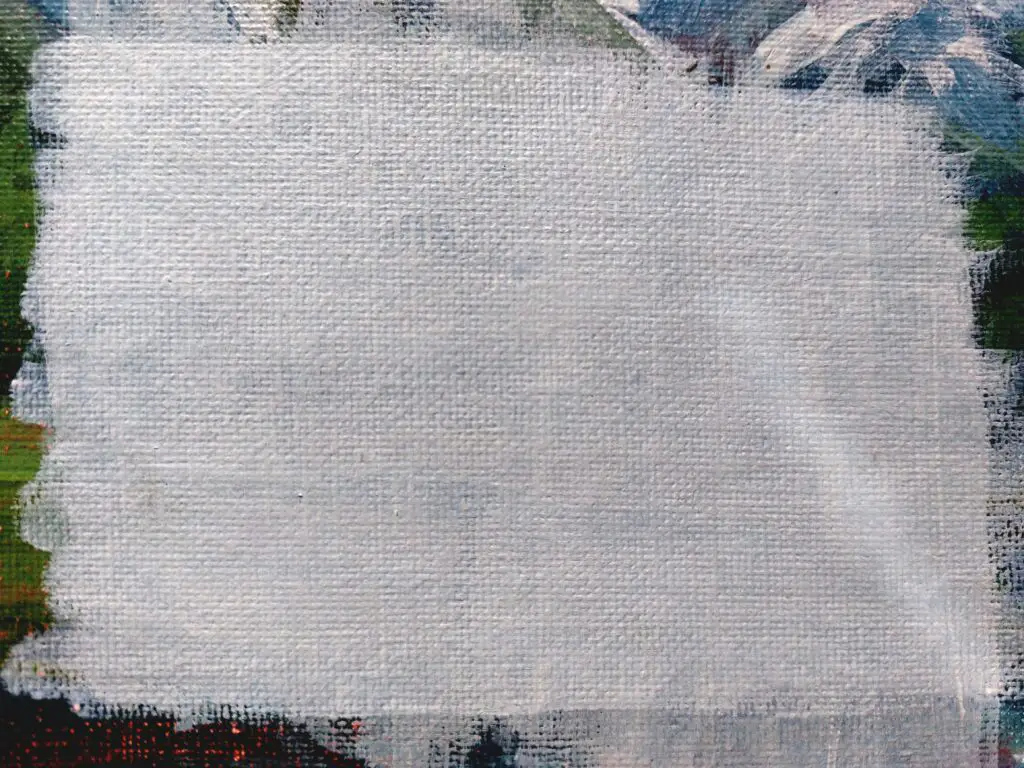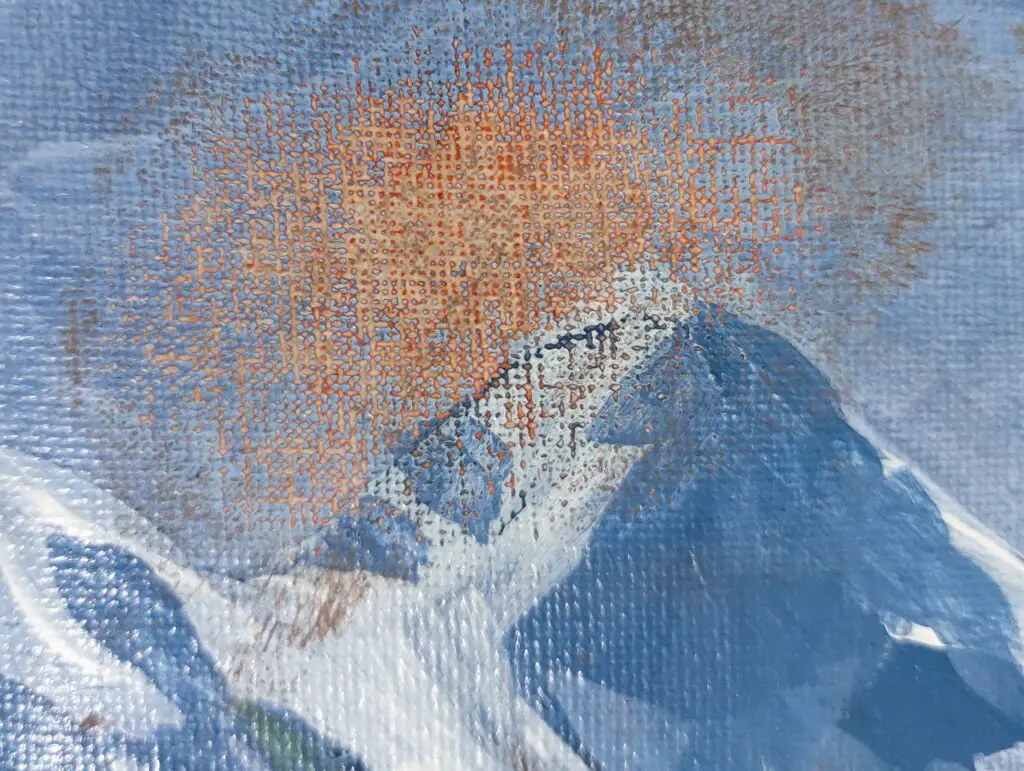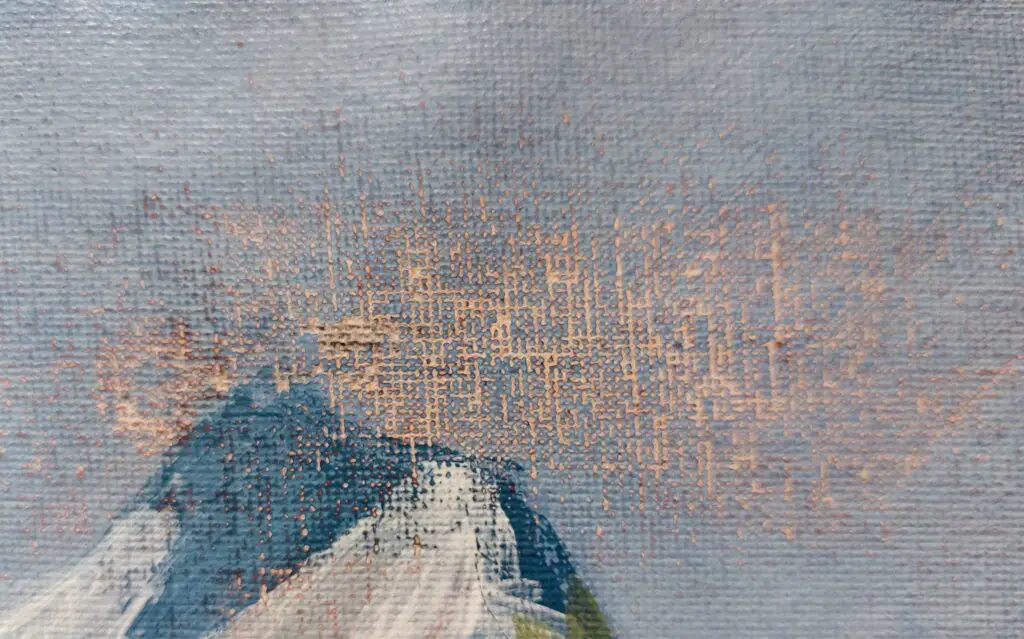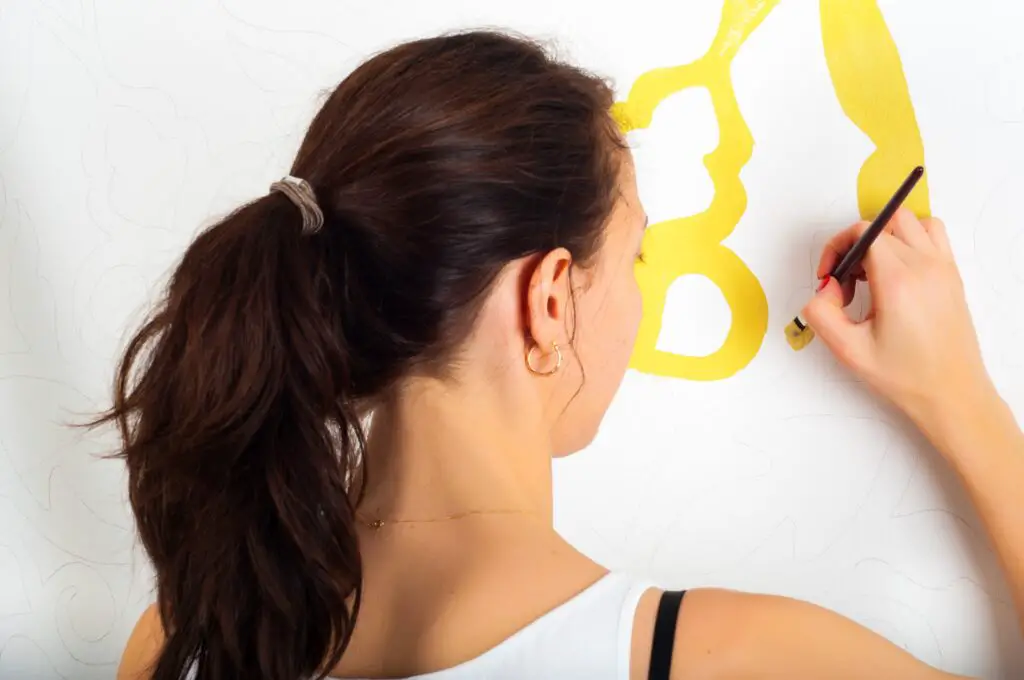Every acrylic artist whether it is a professional, hobbyist, or a total newbie makes mistakes. The best thing is that it is much easier to fix mistakes with acrylic paint, even if you messed up the whole painting. Here is how you can fix a messed-up acrylic painting.
In general, Wet acrylic paint can be removed using a wet paper towel or a wet brush. Painting over with an opaque acrylic color is another option. If the painting is dry apply gesso over the acrylic painting and start over. Soaking overnight in water can remove thick, uncured acrylic paint.
Even though we want to perfect everything in our artwork, there is no such thing as mistakes in art. Mistakes and experiments would lead you to something unexpected and beautiful. Like Bob Ross said, “mistakes are just happy accidents”.
How to fix a messed-up acrylic painting?
Fixing a messed-up acrylic is comparatively easy, as acrylic paint is mostly opaque and fast drying. Acrylic paint can be removed using water, before drying, without affecting the dry acrylic paint layer underneath. If the acrylic paint is dry, paint it over with an opaque color or gesso.
Knowing what mistakes you made is key to fixing them. Mistakes you make with an acrylic painting can be accidental mistakes, changes that you like to see in the painting, or a total scrape of the painting. In each case, the methods you can follow to fix mistakes will differ.
Wet and rub to fix accidental mistakes while painting
When painting you could have made accidental mistakes where your hands could have slipped and made an accidental stroke on the painting. These mistakes are really easy to fix with a little water. Dampen a rag or a paper towel with water. Then wipe the accidental paint stroke away quickly before drying.
You can also use a dampened brush to lift acrylic paint with the circular motion of the brush on the paint stroke. You need to act within the first five minutes of the accidental paint stroke before it becomes ‘dry to touch’ for this wet and rub method to work. The quicker the better.
In case you have spilled acrylic paint on the surface, immediately rub and clean up with a wet rag. If you act quickly there will be no paint stains. Simply paint over and go for corrections, if there are any changes on the paint layers below the paint spill after wetting and rubbing.
If the paint spill has become dry to the touch, you will have to redo the paint layers in most cases. However, first, try to remove the paint spill by using a rag wet with rubbing alcohol. It would remove most of the dried paint spill as well as some paint underneath. Then redo any removed paint layers as needed.
I have written a whole article about ‘How to Fix an Overworked Acrylic Painting- a step by step guide‘. You will find many tips and tricks to fixing as well as avoiding overworking acrylic painting next time.
Reusing an old canvas after applying gesso
To reuse an old canvas, that you don’t like, gesso over the painting. It works both on varnished or unvarnished old acrylic paintings. Wait at least a week after painting before gesso a canvas. Because moisture needs to escape the painting before applying gesso for better adhesion.
We all have those canvases that we want to scrape and start over. This is true for a total beginner or someone have been painting for years. How many paintings do you think in art galleries, are painted on top of an old painting? There would be many of them.
It doesn’t matter that you have messed up an acrylic painting. You can always start over after reapplying gesso on the canvas.

What I worried most when applying gesso over the painting is that it would weigh down the canvas or thicken up the painting so much. But applying one coat or two of gesso didn’t weigh down or thicken up the painting at all. Applying gesso is my favorite way of upcycling old canvases.
What you shouldn’t do when reusing canvas?
When it comes to old cured paintings reapplying gesso is the best method to reuse the canvas. However do not use alcohol, oven cleaner, soaking in water, or any other sort of chemical to remove existing paint from an old painting, especially if painted in thin layers, painting is old and cured.
Below you will see what it’s like to use rubbing alcohol, and water to remove acrylic paint on a dry, thin acrylic paint layer. I soaked rubbing alcohol well onto a small rag and started scrubbing the paint. Also, I soaked three paper towels with water and kept them on the painting.
I covered the wet paper towel area with polythene to prevent water from escaping. This way I could soak the acrylic paint layer well in water. Then started scrubbing lightly with fine-grit sandpaper. But you can use a rag for this.


With both of those methods, I did not get good results. alcohol helped to remove acrylic paint and even gesso. It sort of thinned down the canvas and caused bulging. Also when I tried removing it by scrubbing the paint it damaged the already-thinned canvas. So I do not recommend alcohol to strip acrylic paint off the canvas.
Keeping a wet paper towel on top of the acrylic painting only helped a little to remove old and thin acrylic paint. I do not recommend this soaking method to remove acrylic paint. It could even damage the canvas when we rub hard to remove acrylic paint.
However, you can soak in water, or use alcohol or oven cleaner to remove fairly new, thick paint layers. You’ll be able to peel off those acrylic paint layers easily. If the paint layers are thin and old, the best method would be applying gesso over and restarting the painting.
How to fix dry acrylic paint mistakes (small) on canvas?
To redo a smaller area of a painting, simply paint over the area as suited with opaque acrylic colors. Then build the details on top of the repainted area. Use highly pigmented, artists-grade acrylic colors when fixing mistakes, especially titanium white. Otherwise, you will be frustrated by the transparent student-grade acrylic paint, when trying to cover a painting mistake.
If you are working on a fairly smaller area, you can use rubbing alcohol also, but I do not recommend it as it might damage the canvas. Also, there is a risk of removing multiple layers of paint which you do not want.
Sometimes as you are painting, there might be a certain area in the painting that you would like to redo. This happened to me in the recent mountain painting I am doing. I have painted an area of snow that does not fit right in the composition and is quite different than in the reference photo.
The mountains are black and the snow is white. So to redo the snow I painted some areas again with black which is the mountain color. Then I redid the snow areas in titanium white. It covers the black and previously painted areas nicely as it is an opaque and highly pigmented white color.
The changes can be done in both varnished and nonvarnished acrylic art pieces. If you paint over a varnished acrylic painting, let the painted area dry thoroughly for a week, and then varnish the repainted area.
I have written a whole article on ‘How long acrylic paint to cure? (Comprehensive answer)‘. You will learn more about curing, even the process acrylic paint goes through to dry and cure.
I have also written a comprehensive list of chemicals and materials that can be used to strip and remove acrylic paint. You will be able to easily choose the right method to strip and remove acrylic paint according to your needs and your budget with the handy chart included in that article.
Fixing acrylic paint mistakes on different surfaces
In this article, I have mostly talked about correcting mistakes on canvas and reusing canvases up to now. The same methods can be applied to many surfaces with little tweaks. Let’s see how to correct acrylic paint mistakes on other common painting surfaces.
How to fix acrylic paint mistakes on wood?
Acrylic paint mistakes on wood can be fixed by overpainting with an opaque acrylic color and overpainting with gesso. Stripping acrylic paint using strong solvents like acetone, oven cleaner, and chemical paint strippers or milder solvents like alcohol also works.
These chemicals do well on wood because the wood will withstand chemicals well without being damaged. If you use acetone, oven cleaner, or chemical paint strippers on painted wood, the paint will be deformed and removed easily in no time.
Keep the painted surfaces soaked in the solvents for different lengths of time. keep acetone for one hour, rubbing alcohol for several minutes, chemical paint strippers until the paint is completely blistered or liquified, and oven cleaner for 2 hours on the painted surface.
Rub and remove the chemical solvent along with acrylic paint, once you see that the paint is softened, and deformed. If you think paint stripping is too much work, you can simply gesso the painted surface. Gesso the painting and re-doing the artwork is one of my favorite methods of fixing a messed up acrylic painting.
You can also cover the mistakes with opaque acrylic color and tweak the painting until it looks right for you. It works the same as on a canvas. Make sure to use good-quality acrylic colors with high pigment concentration for good coverage. Liquitex Basics is one of the best cheaper acrylic paint choices for you.
How to fix acrylic paint mistakes on glass and metal?
Glass and metal are rigid surfaces that can handle strong paint-stripping solvents like acetone, chemical paint strippers, and oven cleaner as well as mild solvents like rubbing alcohol. Strong solvents work best and most efficiently when removing acrylic paint from glass or metal. Painting over with opaque acrylic color or gesso is a great option as well.
Some solvents like vinegar might corrode metal. So it is not a great choice to use on metal. Many chemicals work on glass because glass is rigid, smooth, and inert. As the surface is smooth, the paint is easily removable. Use acetone, alcohol, hot water, oven cleaner, or chemical paint stripper to remove acrylic paint on the glass.
You can simply gesso the surface and start over. Let the gesso dry overnight and start painting the other day. You can also paint over with opaque acrylic color over the mistakes. Let the opaque color dry for about 20 minutes and start painting over.
How to fix acrylic paint mistakes on plastic?
Plastics are a bit tricky when it comes to fixing acrylic paint mistakes. Because strong chemical solvents can dissolve and deform the plastic surface along with acrylic paint. What I recommend using to remove acrylic paint on plastic is alcohol, water, or a Magic Eraser.
Keep the plastic surface soaked in alcohol or water for a few hours. Then start scrubbing with a rag to remove acrylic paint. If not you can simply gesso the surface and start over. You can also paint over the mistakes with a highly pigmented, opaque acrylic color.
What makes it harder to fix acrylic painting mistakes?
There are a few things that make it harder to fix acrylic paint mistakes like texture on the canvas, thick paint layers, well-primed surface, varnishing, etc. If you know how these things make it harder to fix acrylic paint mistakes you will know what to expect from your revamped acrylic painting.

Any painting done with thin paint layers is harder to get off the surface. Because thin paint layers dry and cure quickly and have better adhesion with the surface. If you have painted with thin acrylic paint layers, I recommend you to paint over with gesso or opaque acrylic colors to cover the mistakes. You can use gesso to paint over a whole painting.
On the other hand, when the paint layers are so thick like in an acrylic pour art, the paint can be removed easily by soaking the surface underwater for a few hours and then scrubbing.
Sometimes it is harder to remove acrylic paint when the painting is sealed or varnished. When using a chemical solvent, the solvent has to remove the varnish layer as well as the paint layers. So it becomes quite difficult, especially when using mildly strong solvents like rubbing alcohol.
How do you make fewer mistakes when painting?
When painting we always make mistakes. As Bob Ross says, these are just happy accidents. Nothing would teach you more than experimenting with new things. However, if you master the fundamentals of painting like proportion, composition, lighting, etc, you are more likely to achieve the desired output.
Another important thing is always referring to a reference photo when painting. Do this as a side-to-side photo comparison. Painting from imagination works only for a few and it’s not necessary to paint from your imagination. A reference photo always helps with proportions, details, and composition in the painting.
One of the most important things when it comes to reducing the number of mistakes in practice. Each time you practice you will learn a few new things that may help to improve your painting skill. Eventually, it will lead to fewer mistakes.
Conclusion
Making mistakes in a painting or messing up an acrylic painting is just a part of the painting process. You will learn from every experiment and mistake. However, Acrylic paint is very forgiving of mistakes. You can simply paint over the mistakes with gesso or an opaque acrylic color or use a solvent to remove acrylic paint.

